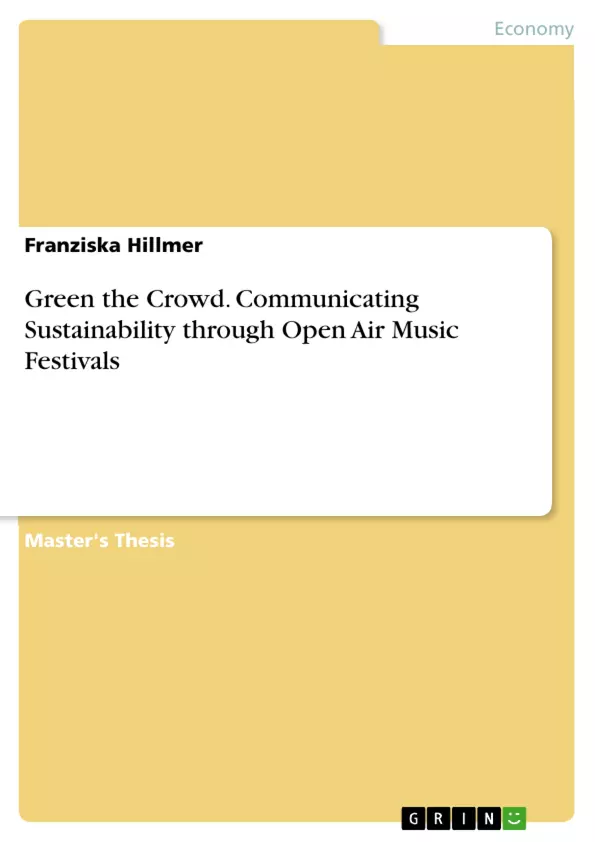“People come in their millions upon millions to our shows and we have the enviable position of a captive and receptive audience.
We are in a position to champion causes, highlight issues
and inspire changing behaviour.”
(Event Professional Meegan Jones 2010: vi)
What do you have in mind, when you hear music festival? Do you think on the first representatives, like Woodstock, as a movement of love and peace against the confrontational direction of the world leaders? Or, more likely, do you think of young adults hanging around without any political intentions? Festivals today are more popular than ever in Germany, but lack the revolutionary spirit of their meaningful ancestors.
But thereby is mankind confronted with the greatest challenges, which indeed are communicated by politicians and business leaders, but not satisfactorily tackled. Weather extremes all over the world remind menkind, with increasing frequency, of the strong dependence of human activities on climate conditions. Climate change has already begun and it looks like it will affect the living generation. These are self-made problems, because they concern those who emit more and more carbon dioxide and use so much of the natural resources that the available amount shrinks drama¬tically (see Sachs 2008: 19 et seq.).
With the rising public awareness for sustainability the companies’ interest to include the topic in their communications strategy has increased, which is also true for the Music Event Industry branch. But while many companies are concentrated rather on green washing than acting like that, some encouraged sustainability efforts do not become public after all, although marketing communication provides a valuable tool for the strategic positioning and is able to inspire people to modify their consumption behaviour (see Meiländer 2011: 52).
Hence, this master thesis attempts to explore, by taking the example of Open Air Music Festivals, how an applied target group specific Sustainability Communication (SC) concept needs to be designed to reach the customer and influence them towards a more sustainable behaviour.
Inhaltsverzeichnis (Table of Contents)
- Introduction
- Sustainability Issues
- Understanding Sustainability
- Sustainability Challenges
- Economic Roots of the Struggles
- Strategies for a Sustainable Development
- Basis of Sustainability Communication
- Communication and Marketing
- Meaning
- Bottlenecks
- Strategies and Instruments
- Businesses Challenge
- Music Festivals - Special Events for the Society and the Music Event Industry
- Meaning of Events
- Development of Music Festivals
- Significance for Economy and Society
- Stop Dirty Dancing - Sustainability at Music Events
- Environmental Impact of Music Festivals and the Demand for Transition
- Sustainability Ambitions in the Music Festival Scene
- Realizing Sustainability Communication
- Incentives for and Demands on the Festival Operators
- Green message - Subtle or Slather
- Communication with and Involvement of Staff and Corporation Partners
- Communication with Attendees
- In Advance Festival Communication
- On-Festival Communication
- Après- Festival Communication
- Empirical Study about the Expandability of Sustainability Communication through German Festivals
- Research Demand
- Research Design
- Evaluation of the Survey
- Return
- Description of the Festival Fan Sample
- Sustainability Measures in General
- Tickets and Mobility
- Framework Program
- Sale of Goods
- Waste
- Derived Sustainability Communication Concept
- Types and Functions of Communication Concepts
- Sustainability Communication Concept for Open Air Music Festivals
- Analysis
- Communication Challenge and Targets
- Strategy
- Realisation
- Conclusion
Zielsetzung und Themenschwerpunkte (Objectives and Key Themes)
This master's thesis examines the potential of open air music festivals to promote sustainability communication. It explores the challenges and opportunities of incorporating sustainability messages into music festival culture, with a particular focus on the German festival landscape.- Sustainability challenges in the music festival industry
- Communication strategies for promoting sustainability
- The role of festivals in shaping societal attitudes toward sustainability
- The effectiveness of sustainability communication at music festivals
- Developing a communication concept for sustainable practices at music festivals
Zusammenfassung der Kapitel (Chapter Summaries)
The first chapter introduces the topic and outlines the research question, exploring the potential of open air music festivals as a platform for sustainability communication. Chapter 2 examines the key challenges and concepts of sustainability, including the economic roots of environmental problems and strategies for achieving a more sustainable future. Chapter 3 focuses on the fundamentals of sustainability communication, including strategies for effective messaging, overcoming communication barriers, and the role of businesses in promoting sustainable practices. Chapter 4 delves into the significance of music festivals as social and economic events, discussing their historical development and their impact on society. Chapter 5 investigates the environmental impact of music festivals and the growing demand for sustainable practices in the event industry. Chapter 6 explores how sustainability communication can be effectively implemented at music festivals, focusing on the role of festival operators, staff, and attendees. Chapter 7 presents an empirical study investigating the effectiveness of sustainability communication at German festivals, analyzing survey data from festival attendees. Chapter 8 outlines a sustainable communication concept for open air music festivals, identifying communication challenges, targets, strategies, and implementation plans.Schlüsselwörter (Keywords)
This master's thesis focuses on sustainability, music festivals, event management, communication, marketing, and environmental impact. It explores the potential of music festivals to promote sustainable practices and engage audiences in environmental issues through effective communication strategies.- Quote paper
- Franziska Hillmer (Author), 2012, Green the Crowd. Communicating Sustainability through Open Air Music Festivals, Munich, GRIN Verlag, https://www.grin.com/document/276346



